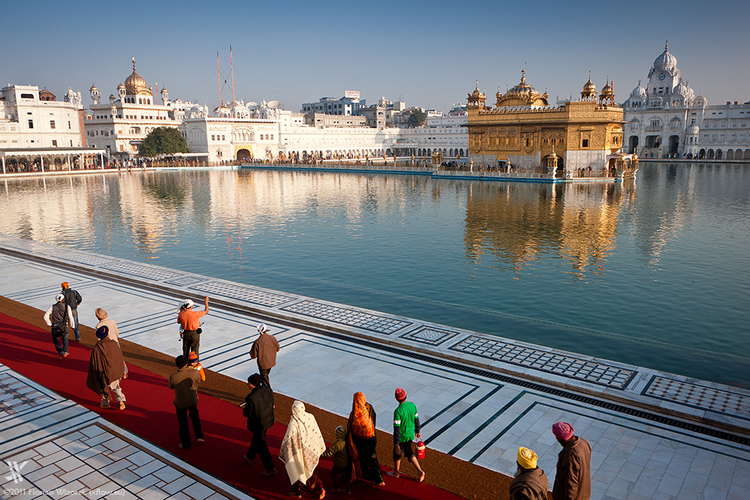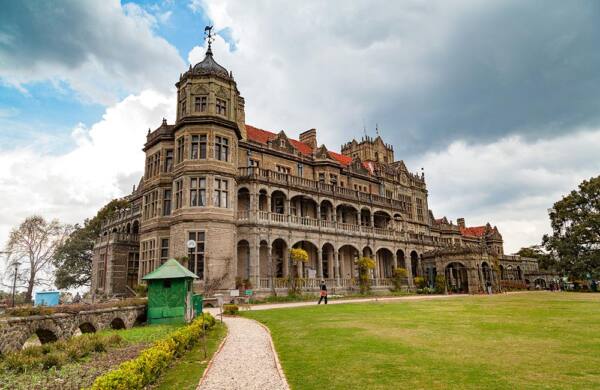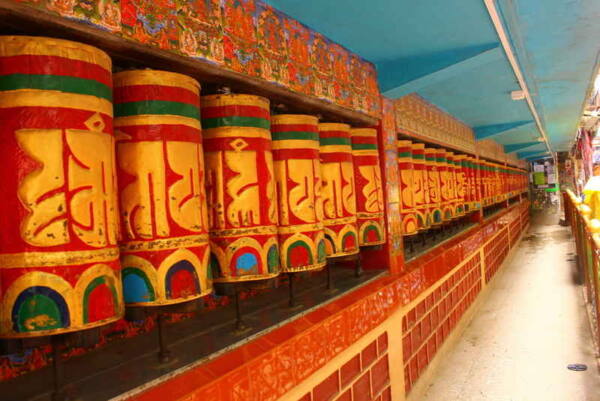12 DAYS/11 NIGHTS
Want to Know More About The Tour?
ABOUT
Travel through the Indian foothills of the Himalayas where you will witness the region’s stunning scenery, rich heritage and diverse culture. Enjoy breathtaking views of the snow-capped Himalayas, marvel at the Golden Temple in Amritsar, the holy city of the Sikhs. Visit the present day home of His Holiness the Dalai Lama and round off your journey in Shimla, the hill station which became the summer capital of India during British Raj .
Pre-departure planning is important. Here are certain things you should watch for and plan for.
Visas
Check with the Indian consulate or embassy in your country to find out if you will need a visa to visit the country of your destination, especially for an extended period of time. Some countries have extremely detailed and complicated entry/departure laws and treat visits of a week or two very differently from longer stays.
Money
If you’re traveling to one area, check the cost of living there. If it’s high you’ll probably want to budget more carefully and save some money before leaving. The lower the cost of living the less you’ll have to save, but be sure to have a back up reserve in emergency cases.
General Tips
Talk to other people who have done a similar trip.
If you don’t know anyone personally, try any of the dozens of online travel web sites full of first-person travel stories covering every possible type of trip.
Plan big and loose. Read everything you can about the area.
There may be sights and attractions you didn’t know about. A rough outline of your trip might have three or four target points and a variety of ways to get between them.
You don’t want to find out that the weather isn’t what you thought, or the guide book was incorrect, after committing to 6 weeks in a specific spot.
Some trips will allow you more leeway than others. Travel plans in Asia can often be made day-by-day while summer travel in Europe should be organized at least a few weeks ahead unless you’re prepared to hunt around for hotel rooms and train seats.
Set up a pre-trip time-line so you don’t end up with a full to-do list during your last week of work or school.
Things to consider are doctor’s visits for a check up, inoculations, and prescription refills; purchasing plane tickets; renewing passports and obtaining visas and other documents.
Check your insurance coverage abroad and purchasing additional travel insurance if needed. Don’t forget visiting friends and family members!e
The longer the trip, the lighter you should pack. This might seem strange, but it’s true you can afford to lug a heavy bag around for a week or two, but do you want to have anything extra for a year?
Stick to the absolute basics and know what you can and cannot buy at your destination(s). There’s no point in bringing 6 months of toothpaste to Europe or buying a sarong at home to take to the tropics. If you are visiting several climates, try to arrange it so you visit the warmer places first and coldest last. That way you can purchase sweaters and long pants and not have to carry them any more than needed. Alternately, visit cold climates first and then ship unneeded layers home — or sell them off.
A good rule of thumb is to bring one outfit for the hottest day you’re likely to encounter, one for an average day, and one for the coldest.
Make sure everything goes with everything else (if that’s important to you), and remember that layers are always best.
Be prepared for uncomfortable trips. You will often find yourself in a busy, cramped, economy class environment and it could be for many hours – especially long plane trips.
If you want to arrive at your destination refreshed and able to enjoy the sights, then try a good quality travel pillow to support your head, some earplugs to block out the screaming babies, and an eye cover to block out the sun or cabin lights.
Just avoid those cheap U-shaped pillows from airport shops – your head drops forward and you wake up with a stiff neck.
Make contact with the locals before you go.
Maybe you have a friend-of-a-friend or a foreign exchange student from high school you remember, or just found a friend through a travel web site; almost everyone is happy to welcome a foreign visitor to their home town. This might be as elaborate as a home-stay for a few weeks, or just coffee in their home town or dinner at a locals restaurant.
Getting Around
Make your own way or if there are too many great things to see, follow the lead of a guided tour.
A perfect city for exploring on foot with a shop around every corner. Much of the inner city can be walked without trouble, however, in parts walking includes crowds, uneven streets, heavy traffic, and skinny sidewalks. If that’s a problem, there are plenty of taxis to ride in and scooters to rent.
How to Travel
- Subway – The metro is the fastest transportation. Running 5 am to 10 pm every day in all Major Cities of India.
- Bus & Train – Operated by an independent organization, buses, and trains include wifi access for the public. You can take any bus or train marked with the (B Public) sign for free.
- Taxi – Available in all parts of the city. From a restaurant or hotel, you can have them call the city taxi service.
- Car – Rental cars are easy to get and hotels have good parking prices. Once in the main city, you can often walk so we suggest returning the when you arrive.
- Bike – The best way to get around, other than walking, is by bike. If you don’t mind hills, you can bike anywhere. If that’s not for you, stick to the inner city with your bike.
Mini Trips
Just a few miles away you can explore the history and legacy, drink wine and relax. You can wander the hills or be lulled by the fountains. If you have time, the attractions can fill 3 days. We’ve highlighted the best ones here.
Tours
Because of the number of sights to see, some first-time visitors should start with an organized tour. Some things can be covered in-depth, others are just useful for getting your bearings.
The leading tour operators use local historians to lead their tours. Guides offer walking tours, including visits to monuments, museums, and historic locations, as well as eating tours. Tour prices can be high, but most participants consider them a trip highlight. In addition, there are many family-related tours, sights, and more appealing activities for children.
Walking tours, like the 3-hour ghost tour, is exclusive in the early evening. A bus excursion ruins special tours like you’ve never seen. Also worth consideration, a group of art historians and architects do a theatrical retelling of dramatic scripts. Go on a tour, and expect guides to break out into a rendition of “Singing in the Rain”, it’s a lot of fun.
- Amristar Golden Temple
- Kangra Valley
- Dharamsala – Home to Dalai Lama
- Taragarth – Monestries and Temples
- Shimla Magnificent Scenery
- Old and New Delhi – Red Fort
T ravel Resources
Travel planning is about more than just knowing where you’re going. Prepares to navigate, take control and be ready for anything. This section helps you steer clear of disaster and stay open enjoy the unexpected.
Quick Tips
- Banks – Open Monday to Friday 9am to 2pm. Some banks are closed for lunch.
- Emergencies – For police, dial a local phone number; for ambulance call a hospital.
- Internet Access – Wifi is standard in most hotels and free in many coffee shops.
- Mail – Buy stamps at the Post Office. Convenient post offices are located all cities. Most are open Monday to Friday 9am to 3pm.
- Safety – Pickpocketing can be a common problem. It is suggested for men to keep wallets in their front pocket. Purse snatching also occurs at times.
Visitor Information
This site contains information with a very personal and friendly structure. It also has great links to other related sites online.
Information, internet access, maps, and train passes are available at local Tourist Information terminals. These are located at various sites around the city. Expect a wait if you arrive late in the afternoon or during lunch time. Local travel agencies are also helpful for quick information and finding hotels. There is no service charge for these services. Hours are Monday to Friday 9am to 5pm, and Saturday 10am to 2pm.
Transportation
Getting in from the airport and other arrival locations. Travel planning is about more than just knowing where you’re going. Prepares to navigate, take control and be ready for anything. This section helps you steer clear of disaster and stay open enjoy the unexpected.
- Plane – Flights arrive at the main airport near city center. If flying from European cities, you might land at a connecting airport. There is a tourist information office at the Terminal E, international arrivals, open 8am to 6pm.
- Train – A train station is on the lower level of the airport. To get into the city, follow the marked signs.
- Taxi – From the airport there is a flat-rate for the 1-hour trip, depending on traffic. Hotels charge up to $80 for shuttle service.
- Train & Bus – Trains and buses arrive a city center. This is the transportation hub for the city and is surrounded hotels.
A perfect place for exploring on foot, with local shops around every corner. You will eventually walk somewhere, it’s just going to happen. If you don’t like crowds, uneven cobblestones, heavy traffic or narrow sidewalks, take a taxi or rent a scooter.
Fly to Delhi on reaching you will be greeted by a Horizon Worldwide representative and transferred to your hotel and assisted with check In. For the rest of the day free to relax and explore Delhi on your own.
Morning flies from Delhi to Amritsar, where you will be greeted by our representative, transfer to your hotel, and assisted with check-in. The rest of the day is at leisure to explore Amritsar on your own or relax at the hotel. The second-largest city in Punjab, Amritsar was founded in 1577 by Guru Ram Das, the fourth Guru of the Sikhs, and is now considered the center of the Sikh religion. Today the main attraction is the famous Golden Temple, the holiest of Sikh sites, the city takes its name from the sacred tank located within the temple.
After breakfast, start a full-day private, guided tour of Amritsar. Begin with a visit to the Harmandir Sahib, informally known as the Golden Temple, the temple is a Sikh gurdwara (place of worship) of great significance and is effectively the spiritual center of the Sikh faith, built from white marble and copper gilt with the dome covered with gold leaf, over 100,000 people visit the shrine each day to worship. Many Gurdwaras have common kitchens, known as a Langer, that provide free food to people of all religions and faith. The largest Langer is the one located within the Golden Temple which provides food for over 30,000 people a day, an extraordinary feat made possible purely by donations and volunteers. Continue on to visit Jallianwala Bagh, which commemorates the hundreds of innocent Indians killed or wounded by British bullets in the most notorious massacre under British rule. In the late afternoon, you will visit the Wagah Border, to witness the elaborate flag ceremony or closing of the border between India and Pakistani, which has taken place each day just before 5 pm since 1959. The pomp and pageantry of the Beating Retreat and the Change of Guard within handshaking distance of the Indian and Pakistani forces make for a fascinating spectacle.
After breakfast depart Amritsar and drive up into the Kangra valley amidst the foothills to Pragpur which will take approximately 4 hours. The remainder of the day is free to relax and enjoy the spectacular surroundings or enjoy a walk around the village, which was designated a heritage village in 1997.
After breakfast depart Pragpur and enjoy the short, scenic drive to Dharamsala which will take approximately 1.5 hours. Dharamsala, the current home of his holiness the Dalai Lama is located in the Kangra valley, in the Dhauladhars Mountains. Dharamsala has been connected with Buddhism for a long time, with many monasteries having been established in the past. However, in the 8th century, these monasteries declined, with Hinduism experiencing a revival. The local Gaddi people are now almost all Hindu. When the Dalai Lama left Tibet, the then Indian Prime Minister Jawaharlal Nehru offered to permit him and his followers to establish a “government-in-exile” in Dharamsala. Since then many Tibetan exiles have settled in the town, today numbering several thousand. Most of these exiles live in Upper Dharamsala, or McLeod Ganj, where they have established temples and schools. The town is sometimes known as “Little Lhasa”, after the Tibetan capital city.
Today enjoy a guided tour of Dharamsala visiting Gompas, the Tibet Museum, and the Library of Tibetan Works and Archives. During the afternoon visit the Norbulingka Institute where Tibetan arts and crafts including wood and metal craft, silk weaving, and thangka paintings are kept alive. The evening is free to explore McLeodganj, originally the home of the semi-nomadic Gaddi tribe; McLeodganj is today the residence of His Holiness, the Dalai Lama, and thousands of Tibetan refugees.
Today you will head to Taragarh, a drive of approximately 2 hours, and check in to the Taragarh Palace. Situated by a forested estate and surrounded by the tea gardens of the Kangra valley, one of the most scenic and unexplored areas of Himachal Pradesh. Located at a height of 1000 meters, Taragarh Palace is at the foot of the Dhauladhar Mountains with splendid views of surrounding snow-capped peaks. Formerly known as Alhilal, the palace was built in the early 1930s as a summer resort and It was acquired by the royal family of Jammu and Kashmir in 1951.
Early morning drive to Shimla, approximately 8 hours. Sit back and admire the spectacular scenery stopping en route at Mandi, renowned for its 81 old stone temples and their enormous range of fine carving, as well as its old palaces and notable examples of ‘colonial’ architecture; before continuing on to Shimla. Shimla which was formerly known as Simla is the capital city of Himachal Pradesh. In 1864, Shimla was declared the summer capital of the British Raj in India. The city of Shimla is draped in forests of pine, rhododendron, and oak and experiences mild, pleasant summers and cold, snowy winters. The city is famous for its buildings styled in Tudorbethan and neo-gothic architecture dating from the colonial era.
Today spend the morning on a sightseeing tour of Shimla you will begin with a visit to the Viceregal Lodge, designed by British architect Henry Irwin and constructed in the Jacobethan style between 1880 and 1888. Formally the residence of the British Viceroy of India the lodge today houses some of the most ancient articles and photographs dating back to British rule in India. Continue on to visit the Hindu Temple containing shrines to the many and various Hindi gods. After a stop for lunch take a leisurely stroll along the Mall Road, one of the principal streets in Shimla; the Mall is largely closed to traffic and so has become a popular place to walk and enjoy the shops and cafes lining the road. Along the way, it may be possible to have a quick look inside the Gaiety Theatre, or alternatively find a spot for refreshments whilst viewing snow-capped Himalayan peaks (if the weather is clear) in the distance.
Today will be a real highlight as you enjoy a short ride from Shimla to Taradevi on the “Himalayan Queen’, the narrow gauge or ‘toy’ train that runs between Shimla and the railhead at Kalka. The journey is one of the most scenic train rides in India, constructed between 1898 and 1903 with 864 bridges and currently utilizing 102 tunnels it was declared a UNESCO world heritage site in 2008. On arrival in Taradevi, you will be met and driven back up to Shimla to spend the remainder of the day relaxing.
Today you will travel to India’s capital Delhi, after checking out of the hotel drive approximately 3 hours down to Kalka to board the late afternoon train to Delhi. On arrival, you will be met by our representative and transferred to your hotel.
Transfer to the airport for your international flight back Home.



